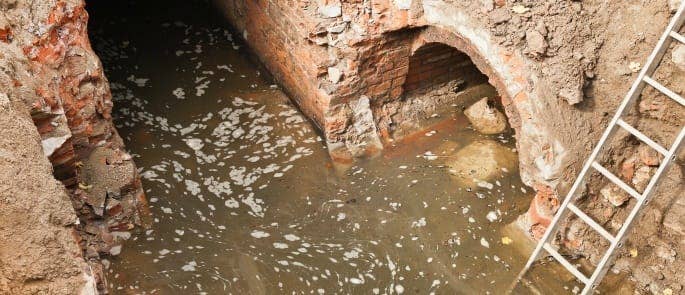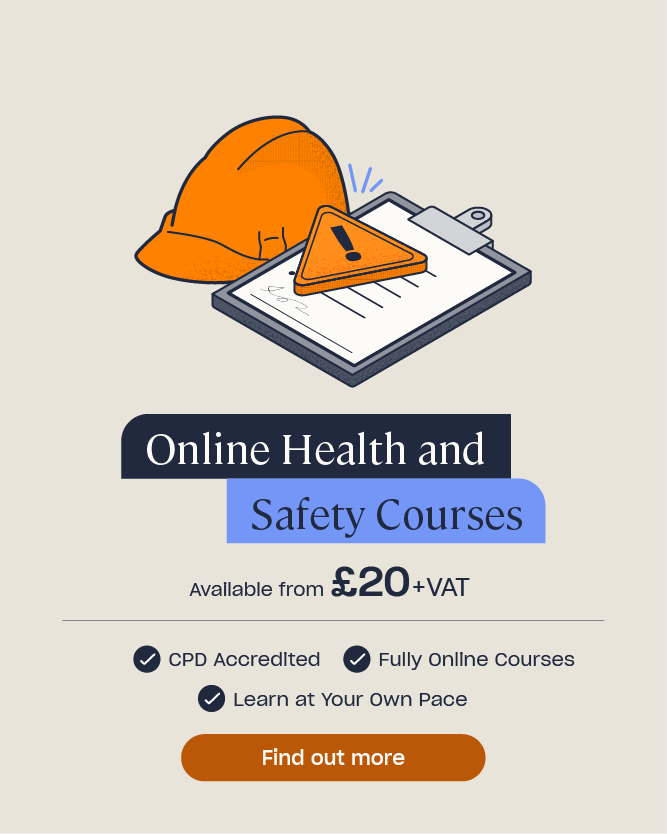A Guide to the Most Common Workplace Hazards
To complete the first step in any workplace risk assessment, you must identify the hazards in your workplace. Every workplace has hazards and, although there will be a nominated person for conducting formal risk assessments, it is still everyone’s responsibility to be mindful of hazards in the workplace and minimise risk of harm.
Not all hazards are obvious and they will be unique to your workplace. This can make it difficult to immediately identify and protect your employees from them. Therefore, we have created this guide to help you understand the different categories of hazards and where they might be present.
What Are the Most Common Hazards in a Workplace?
The words ‘risk’ and ‘hazard’ are often used interchangeably. However, if you are responsible for managing the health and safety in your workplace, it’s important that you understand the difference between them. The rest of this article focuses on hazards, including where they might be found in different workplaces. We also provide you with a range of further resources to make your risk assessment process as smooth as possible.
The six main categories of hazards are:
- Biological. Biological hazards include viruses, bacteria, insects, animals, etc., that can cause adverse health impacts. For example, mould, blood and other bodily fluids, harmful plants, sewage, dust and vermin.
- Chemical. Chemical hazards are hazardous substances that can cause harm. These hazards can result in both health and physical impacts, such as skin irritation, respiratory system irritation, blindness, corrosion and explosions.
- Physical. Physical hazards are environmental factors that can harm an employee without necessarily touching them, including heights, noise, radiation and pressure.
- Safety. These are hazards that create unsafe working conditions. For example, exposed wires or a damaged carpet might result in a tripping hazard. These are sometimes included under the category of physical hazards.
- Ergonomic. Ergonomic hazards are a result of physical factors that can result in musculoskeletal injuries. For example, a poor workstation setup in an office, poor posture and manual handling.
- Psychosocial. Psychosocial hazards include those that can have an adverse effect on an employee’s mental health or wellbeing. For example, sexual harassment, victimisation, stress and workplace violence.
Need a Training Course?
Take a look at our range of Online Health & Safety Courses, where you’ll find courses such as Risk Assessment, Asbestos Awareness and Accident and Incident Investigation.
Examples of Workplace Hazards
Below you will find a non-exhaustive list of hazards that can be found in a range of work environments. The aim of this guide is to help you understand the different categories of hazards, so you can confidently identify them in your workplace.
Biological Hazards
Biological hazards include viruses, bacteria, insects, animals, etc., that can cause adverse health impacts. These health impacts can range from skin and respiratory system irritation, to the transmission of infections.
Some biological hazards include:
Blood-borne diseases, including HIV, hepatitis B and C, and malaria
Blood-borne diseases are viruses or bacteria that can be transmitted through contact with infected blood or bodily fluids. Those most at risk from blood-borne diseases are those working in the healthcare sector, for example, doctors, nurses and dentists. However, many other professions can be at risk, such as cleaners, waste and refuse collectors, street cleaners, park keepers and tattoo artists. Simply put, anyone who might encounter sharps at work is at risk. Incidents that pose a risk for blood-borne disease transmission can have serious health and psychological impacts. Our Sharps & Needlestick Risk Assessment Template may help you take steps to reduce the risk of an injury in your workplace.

Bacteria, moulds and fungi
Improperly managed work environments can make your work premises the ideal environment for bacteria, moulds and fungi to thrive, such as Legionella bacteria. Exposure to bacteria, moulds and fungi can result in severe health impacts, such as Legionnaire’s disease and respiratory disorders, and could exacerbate allergies. Workplaces most at risk include spa pools, textile and print industries, and paper manufacturing, however any humid work environment can be at risk.
Flour, milk powder or grain dusts
Exposure to organic dusts can result in severe health impacts, including respiratory irritation and occupational asthma. Those at risk include individuals working in food manufacturing and preparation, such as in a bakery.

Other organic dusts
The deterioration of building materials, as well as building, construction and agricultural activities, can expose workers to a range of organic dusts, moulds and bacteria – including clay and straw dust. Exposure to these can result in exacerbation of allergies, respiratory and skin irritation, among other health impacts.
Exposure to animals and vegetation
For example, those working in agriculture or horticulture, people working in zoos or as dog handlers, are at risk of encountering bacteria, fungi, viruses and mites off the animals and vegetation they work around. If not properly controlled, this exposure can result in a range of health impacts, including allergic diseases such as farmer’s lung.
Chemical Hazards
Chemical hazards are hazardous substances that can cause harm. They can be very dangerous but might not always be immediately identifiable in the workplace. For example, when considering who may be at risk, you might not immediately think of hairdressers, florists, cleaners, waiters, bartenders, or nail technicians.
Examples of substances that pose a chemical hazard include:
Cleaning chemicals
Cleaning chemicals are used in almost every workplace to maintain good hygiene standards. Incorrect use of cleaning chemicals can have serious impacts, including allergic reactions, asthma and respiratory irritation, dermatitis and skin or eye burns.
Hair dye, shampoos, conditioners and henna products
These are all substances that we safely use at home without considering the risks. However, hair dye, shampoos, conditioners and henna products, among other substances regularly found in hair and beauty salons, can have serious health impacts if you don’t take the proper precautions. For more information on hazards in a hair salon, have a look at our article: Hairdresser’s Guide to COSHH in the Salon.

Nail glue, nail polish remover, primers and artificial nails, etc
Incorrect use and storage of these substances can result in a range of serious health and safety risks. For example, skin and respiratory irritation, headaches, dizziness, sickness, occupational asthma, cancer and fire hazards.
Welding fumes
Welding activities pose many hazards, including exposure to invisible gaseous fumes. These fumes include ozone, nitrogen oxides, chromium and nickel oxides, and carbon monoxide. Exposure to these gases can cause serious health impacts, including Pneumonia, occupational asthma, cancer, metal fume fever and respiratory irritation. If not properly controlled, the fumes can impact the welder and anyone working in the vicinity.
Physical Hazards
Physical hazards are environmental factors that can harm an employee without necessarily touching them.
Examples of physical hazards include:
Electricity
Exposure to electrical live parts can result in serious injuries and fatalities, including electric shocks, burns, explosions and falls from height. The risk is increased in wet conditions, where a worker’s equipment and surroundings can also become live.
Fires
Every workplace is at risk of fire. However, some workplaces are at an increased risk – either due to the work activities or types or employees/residents. For example, care homes, schools, hotels, organisations that carry out hot work, food manufacturers and restaurants. Fires can be devastating, both to the organisation and to the people impacted, they can cause serious injuries, such as burns, asphyxiation and fatalities. A risk assessment is an essential precaution in fire safety procedures; our free template will help you complete one for your premises.

Confined spaces
Working in confined spaces poses serious hazards to employees. They can be especially dangerous because of the reduced oxygen levels and potential build-up of gases, which can result in fires, explosions, asphyxiation and loss of consciousness. Further risks include collapse and flooding. Examples of people at risk include anyone working in mines, cold storage, tunnels, wells, ship holds, air ducts and manholes.

Extreme temperatures
Exposure to freezing or extreme cold conditions can result in serious health impacts, including hypothermia, reduced mental alertness, chilblains, trench foot and reduced dexterity. Those at risk include anyone required to work outdoors in colder months, or in refrigerated warehouses, including construction workers, emergency response staff, fishermen, and food manufacturers. Conversely, exposure to extreme heat can result in health impacts such as dehydration, heat exhaustion and dizziness. Workers at risk include restaurant staff, launderers, smelters, welders and bakers.
Safety Hazards
These are hazards that create unsafe working conditions. For example, safety hazards include:
- Trailing power cords, loose or frayed carpets and rugs, spills, ice, etc. These could all cause a slip, trip or fall in the workplace, and result in physical and mental impacts on an injured employee.
- Unguarded machinery. Unguarded moving machinery parts pose a safety hazard as employees can sustain serious injury and fatalities if they were to accidentally come into contact with them. For example, clothes, lanyards, hair or body parts could become entangled in unguarded machinery and can result in bruising, broken bones, loss of limbs, head injuries and death.
- Frayed and faulty cords, wiring or cables. These could pose a risk of electric shock, burns and fires. Exposure to live electricity can also result in a fall from height. For example, if an employee sustained an electric shock while using a ladder.

Ergonomic Hazards
Ergonomic hazards are a result of physical factors that can result in musculoskeletal injuries. They can be found in every workplace and, if not managed correctly, can have significant long and short term impacts on your employees health and wellbeing. Musculoskeletal injuries are those that affect the musculoskeletal system, including damage to muscles, tendons, bones, joints, ligaments, nerves, and blood vessels. Types of ergonomic hazards include:
- Manual handling. Manual handling occurs every time you lift, put down, push, pull, carry or move a load using your hands or bodily force. Poor manual handling techniques can have serious consequences unless employees are appropriately trained in their duties. These include long term damage to the individual’s musculoskeletal system and mental health.
- Use of display screen equipment. Most jobs in this current, technological age, will require the use of some form of display screen equipment. Prolonged use of poorly designed workstations can result in a range of ill-health effects, including musculoskeletal injuries, repetitive strain injury, fatigue and eye strain. You can find our DSE training, here.
- Vibration. Long term use of vibrating tools can have serious health impacts including vibration white finger, sensory nerve damage, carpel tunnel syndrome and muscle and joint injuries. For more information on the impact of vibration exposure, have a look at our article: Effects of Vibration on the Body: HAVS Guidance.

Ergonomic hazards can have severely disabling impacts if they are not managed correctly. Therefore, it’s important that you understand how to identify ergonomic hazards at work and take steps to ensure that your employees can carry out their workplace activities safely.
Psychosocial Hazards
Psychosocial hazards include hazards that can have an adverse effect on an employee’s mental health or wellbeing, and are closely linked with all the other categories of hazards. For example:
- Health impacts. Health impacts as a result of biological, chemical, physical, safety and ergonomic hazards can have significant impacts on an individual’s wellbeing. For example, exposure to a blood-borne virus as a result of a sharps injury can result in months of stress and anxiety for the individual involved and their family. Therefore, almost all of the hazards outlined in this article could also result in psychosocial impacts.
- Harassment. Harassment is a result of someone acting in a way that makes you feel intimated, humiliated, offended or otherwise distressed, and can have serious impacts on a person’s health and wellbeing. For example, bullying in the workplace is surprisingly common and can pose a serious psychosocial hazard. Bullying behaviour can result in the bullied individual experiencing several psychosocial symptoms, including stress, anxiety and sleep deprivation, loss of appetite and a sense of vulnerability.
- Workplace aggression and abuse. Whether it’s from a colleague, client or someone else, workplace aggression and abuse can have serious effects on someone’s mental and physical health, resulting in symptoms such as stress, anxiety and sleep deprivation. Managers can take steps to reduce sexual harassment in the workplace and encourage employees to speak out if they witness or experience it.
How to Manage Hazards in Your Workplace
If you neglect your responsibility to protect your employees, you could face financial and/or custodial penalties. Therefore, it’s vital that you properly manage all your workplace hazards. This article should have helped you to identify and consider more obscure hazards, but it’s important that you take further steps to protect you employees. For example, you should:
- Carry out an appropriate risk assessment for the nature of the work and hazards. We have provided some downloadable templates for you to use throughout this article. You can find more, including those that are relevant to your industry, by searching on the Hub.
- Introduce appropriate control measures. Once you have completed your risk assessment, you must introduce controls to reduce or eliminate the identified hazards. For example, you may be able to avoid work at height completely when window cleaning by using extension poles or, if those are inappropriate, you could reduce the risks by installing fall prevention equipment.
- Appropriately train all your employees in their duties. All employees should have appropriate Health and Safety Training or Office Safety Training, in addition to training for any specific workplace hazards.
What to Read Next:
- 15 Workshop Hazards and How to Avoid Them
- Managing Occupational Health in Construction
- Health and Safety When Working with Computers: An Office Guide
- Promoting a Positive Health and Safety Culture: A Guide for Managers
- Warehouse Safety Quiz
- Health and Safety Signs Quiz
- A Guide on Hazards in a Beauty Salon: Free Risk Assessment Template
- How to Avoid Electrical Hazards at Work
- Workplace Health & Safety Quiz
- What is a Dynamic Risk Assessment?
- Working in Hot Weather: Legal Requirements, Guidance, and Tips
- Plumbing Risk Assessment: Free Template
- Workplace Health and Safety Quiz for Employees
- What is the Difference Between Hazard and Risk?
- 10 Ridiculous Instances of Health & Safety Being Taken Too Far
- Online Health & Safety Training











